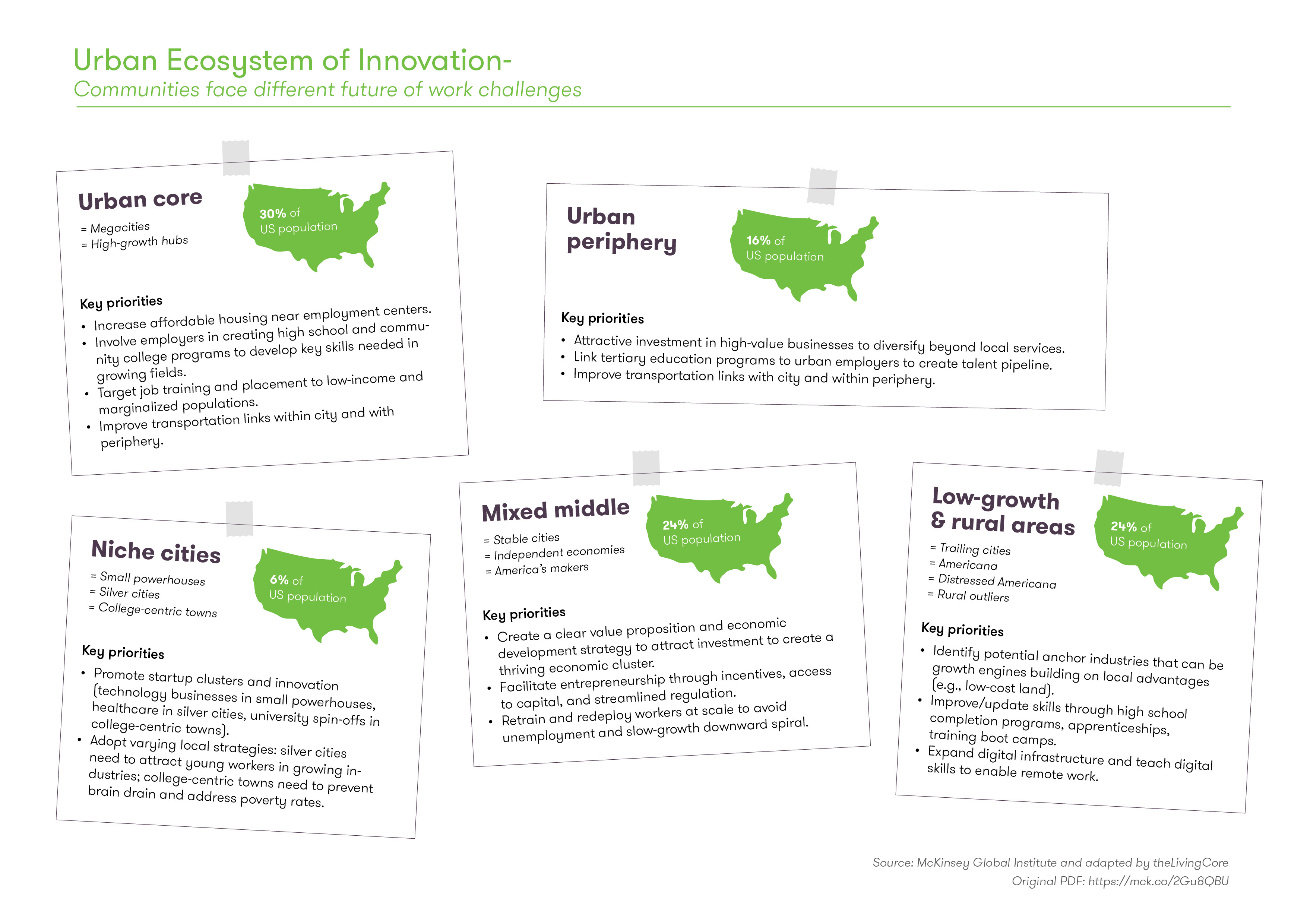Today, as the question of the future of work becomes increasingly urgent, we hear a plethora of different answers. Many of them claim to have a patent remedy at their disposal. Yet, different urban ecosystems face different conditions. While some areas are high-growth innovation hubs, others face stalling growth figures. However, these differences should not hide the fact that all urban ecosystems face the challenges of the future of work. None of the ecosystems presented here can ignore strategic renewal.
The Five Urban Ecosystems
To begin with, let’s take a look at an example; the US. One can identify five different types of urban ecosystems in America. We have compiled them for you in an infographic. But let us also take a look at them one at a time.

Urban Core
The typical urban core of an American city, such as New York is a high growth hub. It accommodates industries such as finance, media, and high-tech. Employment growth is fast. Income is high, workforces are young and well educated. Yet, even though income is above average, so is inequality. Moreover, the urban core is crowded and thus there is a shortage of affordable housing.
It is thus crucial to increase affordable housing and as inequality is high, marginalized populations should be the target of training/education. Moreover, the improvement of transportation links to the periphery grants accesses to the center.
Urban Periphery
The core of large cities such as New York, however, face different challenges than their periphery. On the one hand, the city center doesn’t offer affordable housing near employment centers. The periphery, on the other hand, is cheaper but remote. It attracts a young, educated workforce that commutes to the center. Like the urban core, its surrounding faces vivid migration. Its inhabitants are younger than the American average and they are well educated too. Of course, the periphery is economically dependent on the urban core. Local services, retail, and logistics are the major players on site. Hence, it is important to attract investments in high-value businesses to diversify beyond the periphery’s reach.
Niche Cities
In comparison, smaller “niche cities” are home to a large number of people with tertiary education. The reason for this is that they are often the home of universities. Their population is young and well educated. But it is also in constant flux leading to continued brain drain. It is thus recommended to incentivize startup clusters to keep university graduates on-site to enrich those cities.
Both, urban areas and niche cities feature high growth potentials.
But 48% of the American population lives in the “mixed middle”, on the one hand, and low-growth rural areas, on the other.
Mixed Middle
A quarter of the US population forms the mixed middle. Such cities are stable manufacturing centers. They are “America’s makers”. Neither in need nor striving, they face slower economic and employment growth. Unemployment is above average and the working force has slightly lower levels of education. Some of these cities are on the way up. Others are not. For these areas, it is important to create clear value propositions. This allows them to attract further investment, retain staff, and avoid unemployment.
Rural Areas
And finally, 24% of the American population lives in low-growth rural areas. Many of them are former industrial towns with a struggling economy. Usually, unemployment is higher. Young people tend to leave and educational standards are considerably below the American average. Here, it is critical to identify and revive anchor industries that can rely on local advantages.
Our infographics show the differences between American urban ecosystems at a glance. Of course, its significance for Europe has limits. But within these limits, there is much to learn from.
Source: The Future of Work in America, McKinsey Global Institute, 2019 – graphics adopted by theLivingCore
Image: Jonathan J. Castellon at Unsplash
Subscribe to Our Newsletter
Keep your innovative edge with more stories like this and additional reading tips, muses, and project updates.


